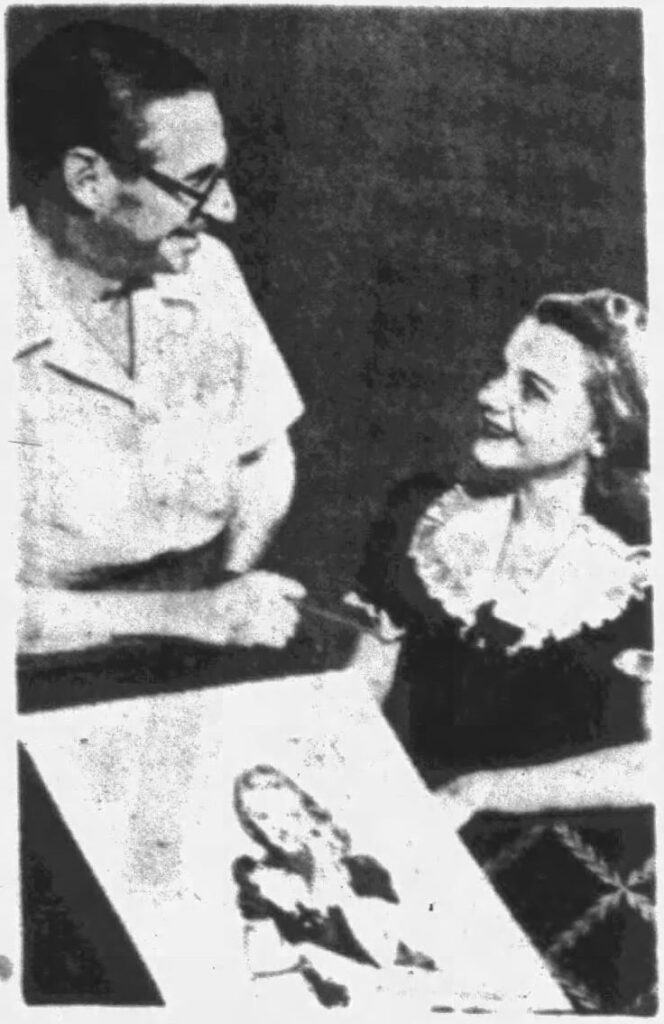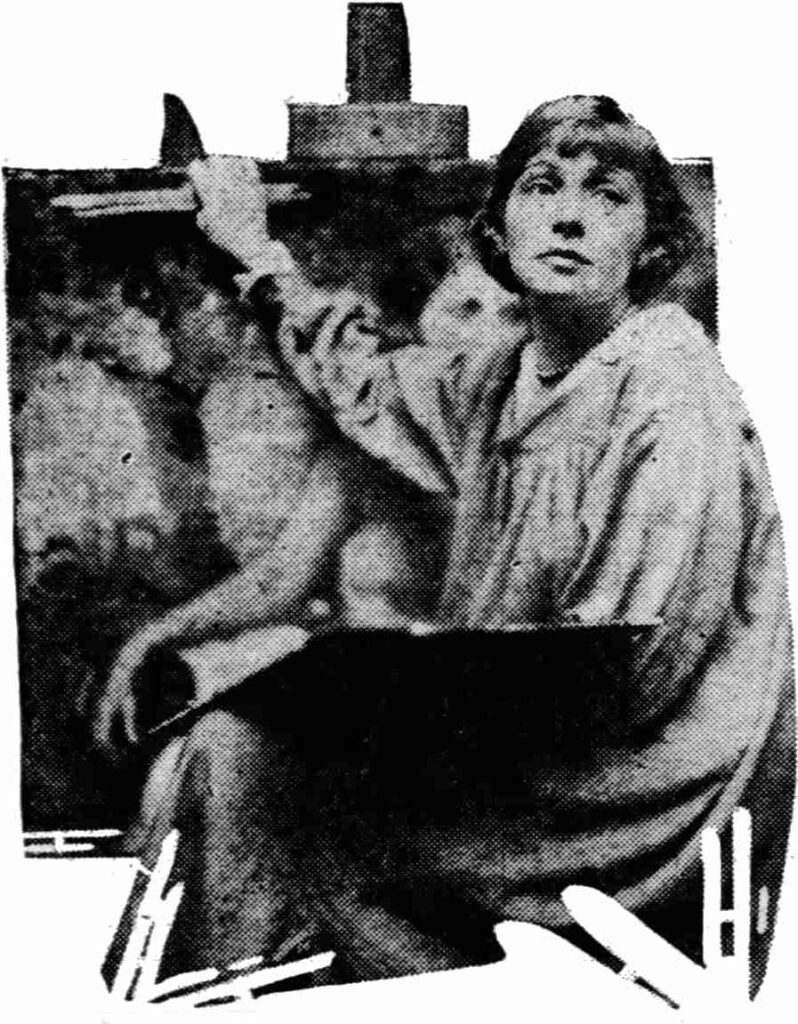In 1937, the City of New York tried to bring art into the ambit of the sales tax that had been passed three years earlier. Only to find out artists can be talented in more than one domain.
From the La Grande Observer, Oregon, May 05, 1937
Artists Up In Arms Because Of The Sales Tax
NEW YORK (AP) — Those dewy-eyed girls on magazine covers, it appears, are “just mental”—whatever their physical charms.
And 300 of the nation’s leading artists and Illustrators poised their paint brushes like battle spears today to prove it.
They will not, they said, pay a red cent in tax on the red lips of their glamor-girl creations—as demanded by the New York City sales tax commission in “cracking down” on artists as a new source of revenue.
Hurls Challenge
“Let ’em try to collect.” said Arthur William Brown, noted illustrator and spokesman for the easel army.

“Artists aren’t bookkeepers,” he said. ”And yet these revenue agents come up and say, “you gotta keep books. You gotta keep books so you can pay the tax.’
“I told this revenuer, ’all right, I’m an artist and you want me to keep books. I’ll keep books, all right, if you’ll draw pictures. How’s that?’ He Just laughed. He said I was another of these cuckoo artists.
“It’s the Idea!”
“We paint a picture of a pretty girl and sell It to a magazine, and the city says we are ’vendors’ — Just like a butcher or baker or grocer — and that we have to pay a two per cent sales tax.”
He winced. “It isn’t the money. It’s the idea. It’s the Idea of calling an artist’s creation a ’product.’ That’s what hurts. A product—as though a work of art were a can of pork-and-beans!”
Brown said more than 300 artists have pledged the amount they would have to pay In 1936 sales tax to fight the levy, and that the movement lists such notables as James Montgomery Flagg, John Le Gatta, McClelland Barclay, Wallace Morgan, Dean Cornwell, and Bradshaw Crandall.
Unfortunately the courts disagreed with them. From the New York Times, 26 Aug 1937
Sales tax on art upheld by Court
2,000 IN APPEAL TO MAYOR
Society of Illustrators Plans Legal Fight, Holding Ruling Unjust to Profession
A storm of protest arose yesterday from artists, illustrators and sympathizers as the result of a decision by the Appellate Division that artists must pay a city sales tax on their work even -when it is lent to publishers for reproduction.
The decision -was handed down June 22 but did not become public until yesterday, when it was printed in The New York Law Journal.
Reached last night at her home at Sands Point, L. I., Miss Neysa McMein, a noted illustrator, announced that she and Arthur William Brown, another illustrator, of 100 West Fifty-fifth Street, acting for the Society of Illustrators, had retained John T. McGovern as attorney to fight the case in the courts.
“We are very much upset about it,” Miss McMein said. “We think it is entirely unjust.”

Henry Fockelman, another illustrator, of 320 West Fifteenth Street, revealed that he recently delivered to Mayor La Guardia petitions signed by about 2,000 artists and sympathizers “protesting against the imposition of the city sales tax upon art and photo-illustration and against the ruthlessness of the emergency division of the Tax Department in waiting more than twenty-seven months to collect back taxes from the vast majority of artists in New York City who did not, and do not now, feel that the tax applied to them at all.”
Mr. Fockelman said that “besides the hundreds of artists who signed the petitions, including some of the most celebrated in their respective fields in the United States, and hundreds of sympathizers, were executives of lithographic concerns, advertising agencies, printing houses and engravers.”
“The bulk of our petitions,” he continued, “were received by the Mayor before a petition with half the number of signatures was presented by Horn & Hardart strikers. They have been granted a public hearing. We have been met with silence.”
The suit on which the Appellate Division’s decision was based was a friendly one brought by John Newton Howitt.
Not a happy ending. But the artists appealed. And won. From the decision of the The Court of Appeals of the State of New York in 1938.
Respondent is an illustrator and artist, and appellant is a publisher of magazines and periodicals. Between May 16, 1935, and April 22, 1937, the appellant paid the respondent $1,410 for the right to reproduce sixteen of his paintings. No right to exhibit publicly the paintings was given, nor were the paintings sold. It was expressly understood that there would be no use, consumption, alteration or defacement of the paintings, and respondent reserved the right to and did in fact sell the paintings. Although delivery of the paintings into the possession of the appellant was not necessary in order that it reproduce them, nevertheless they were given into appellant’s possession, and it sent them to a photoengraving company which prepared blueprints and made final comparisons with the original either in the engraver’s plant or in appellant’s place of business. All this could just as conveniently have been done in the respondent’s studio. The agreed statement of facts stated:
“The only steps in which the original paintings played any part were the photographing thereof for the preparation of the blueprints and the visual comparison of the paintings with the plates and proofs during the touching up and finishing process, and these two steps could just as conveniently have been performed by the photo-engraver at plaintiff’s studio without any delivery of the paintings into the custody of defendant, or the photo-engraver.”
…
A tax law should be interpreted as the ordinary person reading it would interpret it. Referring to this local law, we have said: “A taxing statute must be given a practical construction.” (Matter of Mendoza Fur Dyeing Works, Inc., v. Taylor, supra, p. 281.) And if there is ambiguity it should be interpreted in favor of the taxpayer. We believe that the ordinary interpretation of the word “use” is to assert possessory interest in the article for some length of time; in this case to hold the right to exhibit the picture or sell it or tamper with it in some manner to be decided upon by the purchaser. Anything less than this, as merely the right to reproduce, is not such a use as should make this transaction taxable as a sale of tangible personal property.
The judgment should be reversed and judgment directed in favor of the defendant, with costs.
JOHN N. HOWITT, Respondent, v. STREET SMITH PUBLICATIONS, INC., Appellant
Was that the last word? No. Hillman Periodicals, which published many true crime magazines and a few fiction digests, had to pay tax.
The artists, who were the vendors under their contracts with petitioner, ‘vested’ all rights in petitioner, ‘assigned all right, title and interest’ in the material to petitioner and clearly retained no rights whatsoever in the finished products. Petitioner was given express permission to make necessary changes, and admittedly could correct, retouch and otherwise change the art board after it had been delivered by the artist. These art boards were either consumed in the engraving process or discarded.
Something more than a mere right to reproduce was sold in this case, thereby distinguishing these sales from those reviewed in such cases as Matter of Frissell v. McGoldrick (300 N.Y. 370) and Howitt v. Street & Smith Pubs. (276 N.Y. 345). Here there was an integration of the services rendered into tangible personal properties which were sold irrevocably to petitioner. In the Frissell and Howitt cases the vendors retained title to their integrated products and could still sell these products after return by the vendees. In the latter event, of course, the tax would attach.
In the Matter of HILLMAN PERIODICALS, INC., Petitioner, v. LAWRENCE GEROSA, as Comptroller of the City of New York